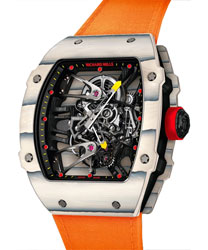Additional Information
Richard Mille’s RM 027 was specifically designed to stand up to the punishment of the tennis court, especially Nadal’s punishing game. With thousands of hours of research and development invested into it, it is designed to be as light as possible so as not to interfere with the player.
And this incredibly lightweight wristwatch was only made possible thanks to the real-life testing ground of the professional ATP tour: repeated shock, sweat, extreme temperature changes, and the various altitudes and humidities associated with being in a different part of the world each week.
The Richard Mille RM27-02 Rafael Nadal watch uses both Carbon and a new quartz filament material which are both created by Swiss NTPT (North Thin Ply Technology). These materials are modified forms of what NTPT produces for high-performance racing and industrial purposes. Meant to be very light-weight and extremely strong, while also resistant to a range of environmental hazards, these quartz and carbon materials are further designed with surface "visual effects" in mind for Richard Mille.
Quartz TPT uses hundreds of layers of extremely thin filaments, produced using quartz crystal as well as (in this case) mostly white resin. The layers of filament are bonded and then specially cut to create the desired wood grain effect. Quartz TPT is used for the case front and back, and NTPT carbon (produced in a similar way to get a wood grain texture) is used for the middle part of the case. Also new for the brand in the Richard Mille RM27-02 Rafael Nadal Quartz TPT is a production technique that uses the caseback of the watch as the actual backplate of the movement.
The second innovation comes from the construction of the watch. Usually, the case and the movement are two totally separated parts reunited in the end of the assembly process and linked by screws. Here, Richard Mille took inspiration from the chassis of racing cars by creating a ‘unibody’ baseplate. In fact, the black band that circled the Richard Mille RM 27-02 (on which the bezel and caseback are attached) and the skeletonized bridges that hold parts of the movement are a single piece of NTPT Carbon. Just like in a racing car, the engine is directly integrated in the chassis. It creates a watch that is first very light on the wrist but mainly that is extremely resistant to shocks (up to 5000g) – something useful when this watch is strapped on the wrist of Rafael Nadal that can strike a ball at 215km/h (130mph).
